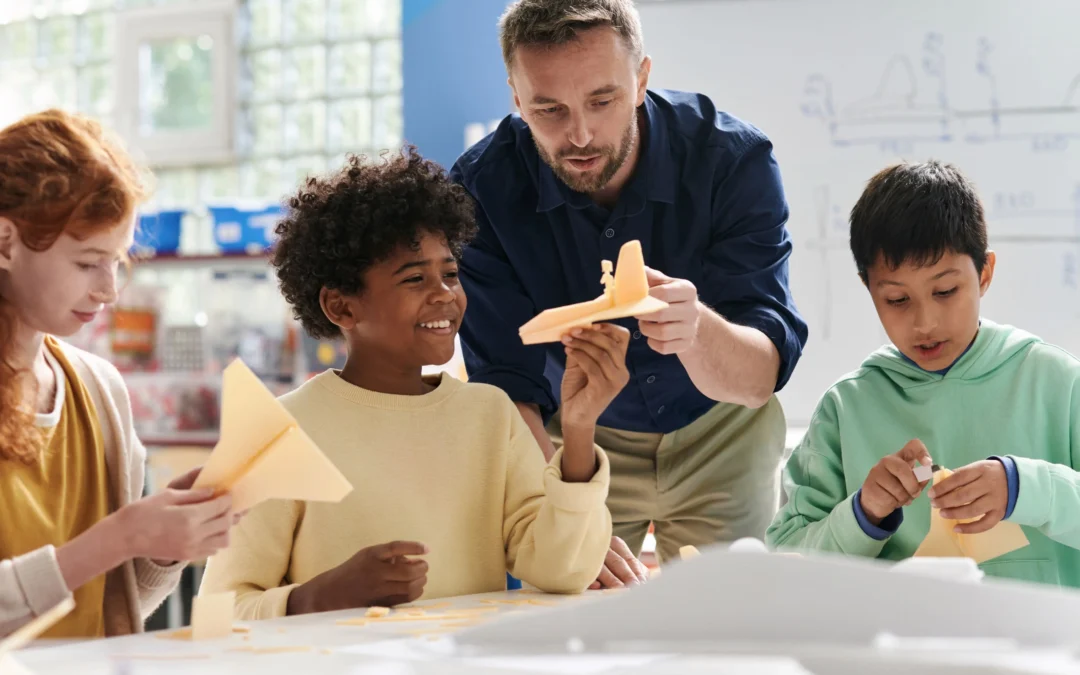Let’s be real—May can feel like a marathon for teachers and students alike. With testing behind us and summer on the horizon, focus starts to fade fast. But the final weeks of school are still a prime opportunity to solidify learning, build community, and finish strong.
At Tools for Success, our CEO and consulting team are all licensed K–12 administrators and spent decades as classroom teachers. We’ve been in the trenches and understand what it takes to keep students motivated when attention spans are running low. That’s why we’re sharing five of our favorite end-of-year engagement strategies—ones we’ve seen work time and time again in real classrooms, across all grade levels.
1. Incorporate Movement-Based Learning
Physical activity isn’t just beneficial for health—it also enhances learning. Integrating movement into lessons can re-energize students and improve focus. Integrating movement into your lessons doesn’t have to be complex. Simple strategies can go a long way in re-energizing students and increasing their engagement—particularly during the final stretch of the school year.
Ideas to Try:
- Elementary: Use “Simon Says” with academic prompts (e.g., “Simon says find something that starts with ‘B’”), or let students move to stations with tasks.
- Middle School: Organize a “gallery walk” where students rotate between posters, questions, or topics to analyze and respond to.
- High School: Implement role-playing or simulations that require students to act out historical events, interpret scientific processes, or problem-solve as a team.
Research shows that when students move, they increase blood flow to the brain, which supports cognitive function, mood regulation, and information retention. According to the CDC, integrating physical activity into the school day can improve concentration, classroom behavior, and academic performance—especially in subjects requiring executive function and problem-solving.
2. Empower Student-Led Reviews
Giving students ownership of their learning isn’t just a strategy for engagement—it’s a catalyst for deeper understanding, accountability, and lasting confidence. When students are invited to take the lead in reviewing content, they move from passive recipients of knowledge to active participants in the learning process.
Student-led reviews encourage peer teaching, a strategy proven to improve both comprehension and retention. According to the Institute of Education Sciences, students who teach others show increased mastery of content and build stronger problem-solving abilities. In addition, these activities strengthen 21st-century skills like public speaking, collaboration, adaptability, and leadership.
Ideas to Try:
- Elementary: Have students create and present short “mini-lessons” on topics they’ve mastered, using visuals, songs, or roleplay to explain concepts to classmates.
- Middle School: Set up peer-teaching stations or small-group rotations where students teach vocabulary, formulas, or historical timelines to one another in quick, interactive bursts.
- High School: Facilitate student-led seminars, debates, or “teach-back” sessions where students analyze texts, defend arguments, or reflect on course themes.
Student-led activities not only reinforce academic content—they also nurture communication, leadership, and critical thinking skills simultaneously. These experiences build confident, collaborative problem-solvers and prepare students for life beyond high school—whether they’re entering a skilled trade, the workforce, or pursuing higher education. They learn to take initiative, advocate for ideas, and engage meaningfully with others—skills that carry far beyond the classroom.
3. Connect Learning to Real-World Applications
One of the most effective ways to re-engage students—especially during the final weeks of school—is to show them the real-world relevance of what they’re learning. When students understand how classroom concepts apply to their lives, communities, and future careers, their motivation increases and their curiosity is reignited.
According to the Association for Supervision and Curriculum Development (ASCD), making learning relevant through real-world applications not only increases student engagement, but also improves critical thinking and problem-solving skills.Students are more likely to retain knowledge when they can connect it to authentic contexts, and they’re more invested when they understand the “why” behind the content.
Real-world learning fosters:
- Greater classroom focus, especially for students who may otherwise disengage in traditional academic tasks
- Deeper learning, as students apply knowledge in practical, often interdisciplinary ways
- A stronger sense of purpose, as learners see how their education connects to their interests and future goals
Ideas to Try:
- Elementary: Plan a hands-on science experiment that explains everyday phenomena, like how plants grow or how weather patterns form. Pair it with a walk or journaling activity to observe the world around them.
- Middle School: Integrate current events into social studies, math, or science discussions. For example, use local environmental issues to explore data interpretation, writing persuasive arguments, or understanding ecosystems.
- High School: Invite guest speakers—such as local entrepreneurs, tradespeople, healthcare workers, or engineers—to share how they use academic skills like writing, critical thinking, or data analysis in their careers. Allow time for Q&A to increase student engagement.
By embedding real-life applications into instruction, educators help students see themselves in the learning. They begin to understand not just what they’re learning, but why it matters—a shift that leads to better outcomes now and greater success later.
4. Celebrate Achievements and Reflect on Growth
As the year winds down, students need more than just closure—they need an opportunity to recognize how far they’ve come. Acknowledging progress, both academic and personal, boosts morale, reinforces a growth mindset, and provides a strong emotional close to the school year.
Studies show that reflection helps consolidate learning, especially when students connect their experiences to personal growth. According to research from Harvard’s Project Zero, reflection activities help students become more self-aware, take ownership of their learning, and build metacognitive skills they’ll carry into future grades and life beyond the classroom.¹
Celebration is just as powerful. Acknowledging students’ efforts, perseverance, and small wins—especially in a school culture that values progress over perfection—can increase motivation and engagement, even during those “checked out” final weeks of school. It also strengthens teacher-student relationships and classroom community, both of which are critical to long-term academic success.²
Ideas to Try:
- Elementary: Create a “memory book” where students draw or write about their favorite moments, biggest accomplishments, and proudest challenges they overcame. Include student photos, artwork, and teacher notes.
- Middle School: Host a classroom or grade-level awards ceremony recognizing both academic growth and personal character (e.g., Most Improved in Math, Kindest Classmate, Most Creative Thinker).
- High School: Facilitate end-of-year reflection essays or Socratic-style discussions where students consider questions like: What did I learn about myself this year? What’s one mindset or skill I want to take into next year?
Reflection and celebration give students a sense of purpose and pride in their learning journey. It’s not just about closing out the year—it’s about helping students see that their effort mattered, that they’ve grown, and that they’re capable of so much more than they may have realized
5. Introduce Novelty and Choice
When routines start to feel repetitive and motivation dips—as they often do in May—introducing novelty and offering students meaningful choices can re-energize your classroom. Research shows that both novelty and autonomy stimulate the brain’s reward system, improving focus, engagement, and even memory retention.
Novelty doesn’t mean abandoning structure; it simply means refreshing the format. When students encounter something unexpected or different—like a new way to demonstrate learning or a creative activity—they become naturally more alert and interested.
Offering choice, on the other hand, taps into students’ sense of agency. Autonomy has been consistently linked to increased motivation, persistence, and deeper learning. According to the work of educational psychologist John Marshall Reeve, choice supports intrinsic motivation, particularly when students are given options that align with their interests and strengths.²
Ideas to Try:
- Elementary: Introduce a new game-based activity that aligns with academic goals (like a math scavenger hunt or story-building dice). You might also offer different mediums for showing learning—drawing, building, storytelling, etc.
- Middle School: Let students pick from a variety of final project formats—poster, podcast, short video, or live presentation. Framing it as a “Show What You Know” week increases ownership and creativity.
- High School: Offer a “choice board” of final assignments with varied formats and skill focuses—analytical essay, visual project, research pitch, or creative writing. You can also allow students to propose their own ideas with a quick rubric check.
By breaking the mold and giving students a voice, you make space for renewed curiosity and deeper learning. And perhaps most importantly, you remind students that they’re not just completing school—they’re building the skills and confidence to lead their own learning journey.
Conclusion: Finish Strong, Teach Forward
Maintaining student engagement in May may feel like an uphill climb—but with the right strategies, it becomes a powerful opportunity. These final weeks aren’t just about surviving the school year; they’re a chance to reinforce core skills, strengthen classroom culture, and leave students with a sense of confidence and momentum.
By intentionally incorporating movement, elevating student voice, making learning relevant, celebrating growth, and offering meaningful choice, teachers can spark renewed energy and focus—right when it’s needed most.
At Tools for Success, we know this work because we’ve lived it. Our team of veteran educators and school leaders designs research-backed, real-world PD and coaching that empowers teachers to meet challenges with creativity and clarity.
📅 Need support building a strategy for year-end engagement or planning purposeful summer PD?
Schedule a free consultation today, and let’s work together to help your school finish strong and prepare for what’s next. https://app.acuityscheduling.com/schedule/46d83727/appointment/8522286/calendar/2631488?appointmentTypeIds[]=8522286
Because when teachers feel supported, students thrive—every single day of the year.

